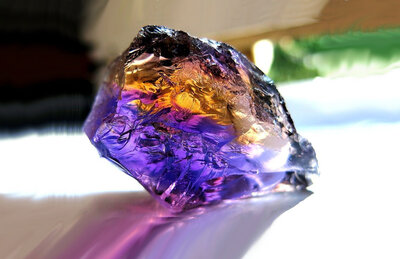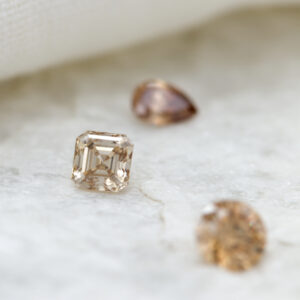Like October babies, those born in November have a choice of birthstones: Topaz or Citrine. Both are relatively affordable and durable and topaz also comes in many different colours so you are sure to find something you like.
Topaz
It’s believed that “topaz” either comes from the Sanskrit word “tapas” meaning “fire” or that it traces back to the ancient Greek island Topazios in the Red Sea, where yellow gemstones were famously mined. Throughout much of history, it was thought that all yellow gemstones were topaz. Eventually gem traders realized that other minerals also had yellow variants, and that topaz could come in other colours than yellow as well. The yellow gemstones mined on Topazios turned out to be the mineral olivine – commonly known as peridot. However, the name topaz stuck.
Topaz colours range from browns, blues, yellows, pinks, purples and sometimes, reds. Colourless topaz is quite common and often treated with irradiation and heat to give it the blue colour that many are familiar with. Natural blue topaz is actually extremely rare. Like many other gemstones, impurities or defects cause the various colours. Chromium causes natural pinks, red or purple colours while imperfections at an atomic level cause yellow, brown or blue. Brown is quite a common colour and is sometimes mistaken for smokey quartz.


Ancient Egyptians believed that yellow topaz received the golden colour from the Sun God, Ra. Ancient Greeks believed that topaz gave them strength. For centuries, Europeans believed that it could thwart magic spells and dispel anger, while ancient Indians believed that when worn above the heart, topaz assured them long life, beauty and intelligence.
Topaz ranks 8 on the Mohs scale of hardness, but it can be prone to chipping or cracking so care must be taken when cleaning.
Citrine
Sunny and golden, citrine is believed to derive from “citron”, the French word for “lemon”. The colour closely resembles topaz, which is why the two have been confused throughout history, however they are two different, unrelated minerals. The yellow hues ranging from pale yellow to honey orange are caused by traces of iron in quartz crystals. This is actually quite a rare occurrence in nature so a lot of citrine is actually the more common amethyst or smokey quartz that has been heat treated.
Because of the misidentification, it was thought that citrine and topaz shared the same powers. It was thought that citrine could soothe tempers, calm the wearer and manifest desires, especially prosperity. To leverage these powers, ancient Egyptians carried them as talismans, ancient Greeks carved them into ornaments and Roman priests wore rings set with huge stones.



Citrine is mostly found in Bolivia, Spain, Madagascar, Mexico and Uruguay. Amethyst that is heat treated to a citrine colour is mostly mined in Brazil. There is also a famous mine in Bolivia that produces a unique combination of amethyst and citrine in the same crystal, which can be cut into a bicoloured gem called ametrine. Citrine rates 7 on the Mohs scale of hardness and is durable enough for normal wear but care should be taken when cleaning as high heat can cause it to crack. As with many gemstones, its safest to clean with warm, soapy water.
We can source topaz in a range of colours, citrine and even ametrine so if any of these gems take your fancy, get in touch with us here to get started.





